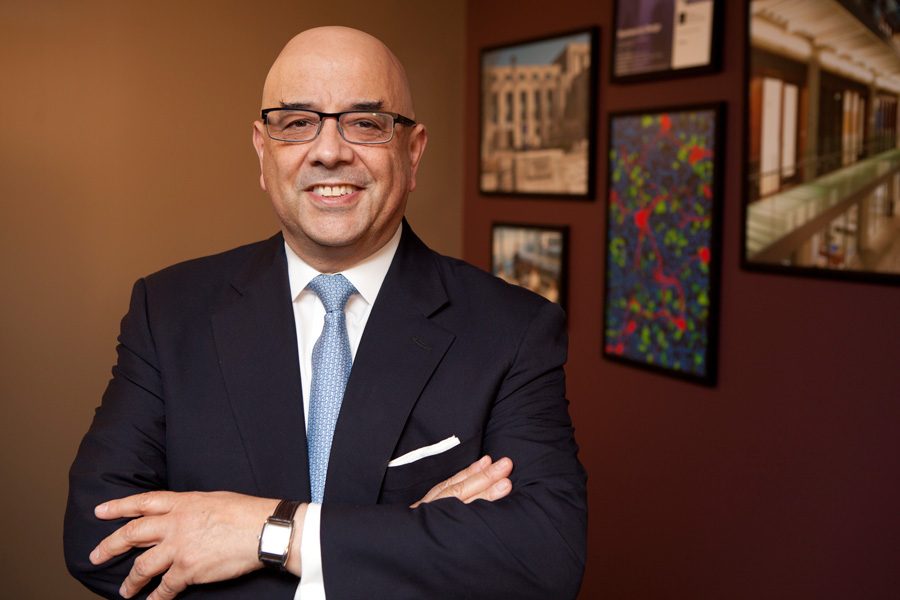McCormick Dean Julio Ottino awarded for ‘Whole-Brain Engineering’ initiative
Photo provided by Kyle S. Delaney
McCormick Dean Julio Ottino
January 10, 2017
McCormick Dean Julio Ottino was named the recipient of the 2017 Bernard M. Gordon Prize for Innovation in Engineering and Technology for his work expanding the McCormick curriculum.
Ottino, creator of the “Whole-Brain Engineering” campaign for McCormick, was honored with the award by the National Academy of Engineering. The award is considered one of the most prestigious in engineering education and recognizes Ottino’s efforts to integrate McCormick’s curriculum into other parts of the University, according to a news release. Ottino will accept the award, which includes $250,000 he will use to fund future McCormick projects, at a NEA ceremony in October.
His wide network of efforts includes partnering McCormick with all other schools at Northwestern as well as several notable organizations outside of the University.
When Ottino first arrived at Northwestern in 1992, McCormick was far more insular with students focusing on more traditional approaches to engineering, he said. He wanted to change that to incorporate all aspects and schools of the University into the undergraduate engineering experience. In 2005, he launched the “Whole-Brain Engineering” initiative based on three pillars: entrepreneurship, design thinking and leadership and personal development.
“It’s an idea with multiple components all moving in the direction of trying to create individuals who are more tolerant of broad thinking than normal people you will create in a classical program in engineering,” Ottino said.
Valuing the intersection of art and design, Ottino said he oversaw the creation of courses partnering with several Weinberg departments in the arts, the Block Museum of Art and Art Institute of Chicago.
Lisa Corrin, director of the Block Museum, said Ottino was quick to introduce himself to her when she first came to Northwestern and was eager to invite the museum to collaborate with McCormick. This year, the Block Museum contributes lectures by artists for McCormick students as part of the art and engineering initiative, Corrin said.
“Dean Ottino is a wellspring of creativity,” she said. “He is a bold thinker who understands that the creative process of artists can serve as an example to designers.”
Ottino said he doesn’t remember what inspired him to create the banner of “Whole-Brain Engineering,” but he has always valued the balance between science and art, and he hopes McCormick attracts students who can apply both in engineering.
The principal way of introducing students to that balance is Design Thinking and Communications, a mandatory class for first-year engineering students that requires them to work in groups to create products for real clients, Ottino said. He said he pushed for a non-lecture class with group work and practical application and design to teach students more skills applicable to working in engineering than the engineering itself.
In opening the foci of engineering courses, Ottino also opened courses to students outside of McCormick. Some of the school’s courses are more than half non-McCormick students — a diversity Ottino said he encourages. Design Thinking and Communications has also been opened to non-engineering students.
“It makes for a much richer learning experience when you have a diverse set of people,” Ottino said. “That makes for a much better course.”
One of the programs initiated under Ottino is the Segal Design Institute, which opened in 2007 and educates designers in engineering and other disciplines, including writing and art. McCormick Prof. Bruce Ankenman, co-director of the institute, said he worked closely with Ottino when he was appointed to direct Segal.
The institute represents one of numerous examples of Ottino’s deft integration of the engineering with a multitude of fields, he said.
“This prize that he’s getting is the highest prize you can get for engineering education, and I think it’s because he is always envisioning what else we should be doing in engineering education,” Ankenman said.
Email: [email protected]
Twitter: @matthewchoi2018


